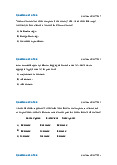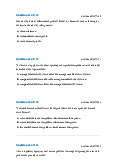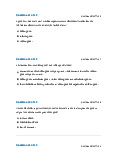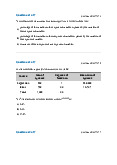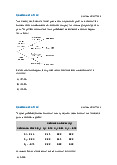





























Preview text:
Basics of Translation Basics of Translation: A Textbook for Arab University Students By Mahmoud Altarabin
Basics of Translation: A Textbook for Arab University Students By Mahmoud Altarabin
This book first published 2019 Cambridge Scholars Publishing
Lady Stephenson Library, Newcastle upon Tyne, NE6 2PA, UK
British Library Cataloguing in Publication Data
A catalogue record for this book is available from the British Library
Copyright © 2019 by Mahmoud Altarabin
All rights for this book reserved. No part of this book may be reproduced,
stored in a retrieval system, or transmitted, in any form or by any means,
electronic, mechanical, photocopying, recording or otherwise, without
the prior permission of the copyright owner. ISBN (10): 1-5275-3754-4 ISBN (13): 978-1-5275-3754-5 Dedication
In loving memory of Dr Sadek Firwana v Contents
Dedication ........................................................................................ v
Contents ......................................................................................... vii
List of Tables .................................................................................. xi
Book Endorsement ....................................................................... xii
Preface .......................................................................................... xiii
Acknowledgments ......................................................................... xv
Chapter I: Introduction ................................................................. 1
1.1 What is translation? ................................................................ 2
1.2 Translation methods & procedures:........................................ 4
1.2.1 Roman Jakobson categories: ........................................... 5
1.2.2 Literal translation ............................................................ 7
1.2.3 Semantic and Communicative Translation ................... 10
1.2.4 Adaptation ..................................................................... 11
1.2.5 Free translation.............................................................. 12
1.2.6 Idiomatic translation ..................................................... 13
1.2.7 Metaphorical Translation .............................................. 14
1.2.8 Translation by addition ................................................. 15
1.2.9 Translation by deletion ................................................. 16
1.2.10 Translating using a general word ................................ 17
1.2.11 Paraphrase ................................................................... 18
1.2.12 Two techniques ........................................................... 20
1.3. Other translation methods by Newmark .............................. 20
1.4 Which strategy? .................................................................... 21
1.5 Equivalence: ......................................................................... 22
1.5.1 Scholarly views: ............................................................ 22
1.5.2 Equivalent effect: .......................................................... 24
1.5.3 Equivalence typology .................................................... 25
1.5.4 Non-equivalence ........................................................... 30
1.6 Translation Shifts ................................................................. 32 vii
1.7 Language variation ............................................................... 35
1.8 Criteria for a good translation: ............................................. 37
Chapter II Translation Problems at Word Level ...................... 39
2.1 Introduction: ......................................................................... 40
2.1.1 What is a word? ............................................................ 41
2.1.2 Classification of meaning.............................................. 41
2.1.3 Meaning and context: .................................................... 45
2.2 Dictionaries .......................................................................... 45
2.3 Lexical gaps ......................................................................... 47
2.3.1 Cultural Domain: .......................................................... 47
2.3.2 Economic domain ......................................................... 52
2.3.3 Technological domain ................................................... 53
2.4 Synonymy ............................................................................ 55
2.5 Polysemy .............................................................................. 61
2.6 Semantically complex words ................................................ 69
Chapter III Translating Collocations and Phrases .................... 71
3.1 Introduction .......................................................................... 72
3.2 What is collocation? ............................................................. 72
3.3 Types of collocation ............................................................. 74
3.4 Collocational meaning ......................................................... 78
3.5 Collocations in Arabic ......................................................... 78
3.6 Problems of translating collocations .................................... 82
3.7 Translation strategies ........................................................... 87
3.8 Translation of Idioms ........................................................... 94
3.9 Translating noun phrases ...................................................... 98
3.9.1 Number: ...................................................................... 100
3.9.2 Gender ......................................................................... 104
3.9.3 Titles, modes of address .............................................. 106
3.9.4 Organizations .............................................................. 110
3.10 Translating adjective phrases ........................................... 113
3.10.1 Classification of adjectives ....................................... 114 viii
Chapter IV Translation at Grammatical Level ....................... 117
4.1 Introduction ........................................................................ 118
4.2 Translating ‘Be’.................................................................. 118
4.3 Translating the ‘Tenses’ ..................................................... 120
4.4 Negation: ............................................................................ 132
4.5 Aspect: ............................................................................... 134
4.5.1 Simple aspect: ............................................................. 134
4.5.2 Complex aspect: .......................................................... 136
4.6 Non-finite into finite: ......................................................... 136
4.7 Translating the ‘Articles’.................................................... 139
4.8 Translating It ...................................................................... 146
4.9 Existential There ................................................................ 148
Chapter V Translation of Sentences ......................................... 149
5.1 Translating English sentences: ........................................... 150
5.2 Translating passive sentences: ............................................ 155
5.3 Translating conditional sentences: ..................................... 157
5.4 Translation problems at sentence level ............................... 159
5.5 Repetition: ......................................................................... 162
5.6 Ambiguity .......................................................................... 167
5.7 Sentence connectors ........................................................... 170
Chapter VI: Text Cohesion ........................................................ 175
6.1 Cohesion and Coherence .................................................... 176
6.2 Cohesive devices in English ............................................... 177
6.2.1 Reference: ................................................................... 177
6.2.2 Substitution ................................................................. 179
6.2.3 Ellipsis ........................................................................ 180
6.2.4 Conjunction: ................................................................ 181
6.3 Cohesive devices in Arabic ................................................ 183
6.3.1 Reference .................................................................... 183
6.3.2 Substitution: ................................................................ 185
6.3.3 Ellipsis: ....................................................................... 185 ix
6.3.4 Conjunctions ............................................................... 187
6.4 Avoid such mistakes ........................................................... 190
6.5 Bad translations: ................................................................. 191
References ................................................................................... 195
Name & subject index: ............................................................... 201 List of Tables
Table 1: Examples of technical vocabulary .................................... 31
Table 2: Examples of English & Arabic cultural terms .................. 31
Table 3: Examples of Islamic economic domain: ........................... 32
Table 4: Language variation in Arabic. .......................................... 36
Table 5: Language variation in English .......................................... 36
Table 6: Collocational meaning ...................................................... 78
Table 7: Transparent idioms ........................................................... 95
Table 8: Opaque idioms: ................................................................. 95
Table 9: Gender in Arabic nouns .................................................. 104
Table 10: English titles. ................................................................ 106
Table 11: Arabic titles ................................................................. 106
Table 12: Forms of address........................................................... 107
Table 13: Academic titles ............................................................. 109
Table 14: Names of organizations ................................................ 110
Table 15: Adjectives functioning as nouns ................................... 116 xi Book Endorsement
Basics of Translation, by Dr Mahmoud Altarabin, a promising writer
on translation, is a well-organized textbook in terms of the translation
students’ level and requirements (Arabic-English). After the general
introduction on translation, chapters are arranged from the smaller to
the larger units of language, starting with translating words, phrases,
grammar, sentences and finally, texts. Indeed, this bottom-up
methodology makes follow-up and comprehension easier to readers
in general and Arab University students of translation in particular. A
mine of illustrative examples and exercises are provided throughout.
I do believe that the book is a good textbook that responds to Arab
students’ translational needs satisfactorily, though not perfectly for
Perfection is God’s. So I recommend it to students of translation of
Arab Universities, Colleges and Institutes in the Arabic-English
direction at the first two levels of their study. Hasan Ghazala xii Preface
This book is an introductory textbook for students of translation at
Arab universities seeking to develop their understanding of
translation issues between Arabic and English. The importance of the
manuscript lies in adopting a bottom-up approach to translation issues
which does not primarily address translation topics as problems and
solutions but rather as critical issues to translation students. The book
features practical exercises following each topic to test students’
understanding of the topic presented earlier. This enables students to
apply their understanding of the topics discussed earlier to translate
lexical units between Arabic and English. Furthermore, this textbook
presents six chapters each discusses translation issues at a different language level.
Chapter I introduces the concept of translation in English and Arabic
and highlights the main translation methods and procedures. These
include literal translation, free translation, adaptation, idiomatic
translation, paraphrase and use of two techniques. The chapter
presents the concept of equivalence and provides some examples of
non-equivalence in different domains, a unique feature of this book.
Additionally, Chapter I familiarizes students with translation shifts,
language variation and criteria for quality translation.
Chapter II discusses certain issues of translating words between
Arabic and English. It begins with defining the concept of word,
meaning, and meaning in context. The chapter later reviews
translation problems related to dictionaries and lexical gaps within the
cultural, economic, and technical domains. Synonymy and polysemy
are two major translation issues dealt with at this level. The chapter
concludes with a brief discussion on semantically complex words and
the possible procedures followed to address such a thorny phenomenon. xiii
Chapter III reviews translation topics at the phrase and collocation
levels. It begins with an introduction on collocations in English and
Arabic and then discusses some problems of translating collocations.
It then presents the strategies adopted to address such problems.
Afterwards, the chapter discusses the translation of idioms.
Translating noun phrases with a particular focus on translation issues
like number and gender is dealt with in another section of Chapter III.
The last section of the chapter discusses the translation of adjective
phrases and highlights significant issues related to the structure and
order of adjectives in Arabic and English.
Chapter IV highlights translation issues at the grammatical level
which are of immense significance to beginner translation students.
The topics included in this chapter are: translating ‘be,’ tenses,
negation, aspect, non-finite into finite, articles, as well as it and existential there.
Chapter V moves to a higher level, the sentence. It discusses the
translation of different types of English sentences such as passive
sentences and conditional sentences into Arabic. The chapter also
highlights some translation problems which students of translation
face at this language level. Chapter V concludes with a discussion on
repetition and sentence connectors.
Chapter VI discusses textual cohesion at the sentence level. It
highlights the difference between cohesion and coherence and gives
background information on cohesion in English depending on
Halliday and Hasan’s book Cohesion in English. Framed within a
translational point of view, this chapter introduces Arabic and English
cohesive devices such as reference, substitution, and conjunctions. xiv Acknowledgments
This book has benefited from the works of many well-known scholars
in the field of translation. I would like to thank Professor Hasan
Ghazala, a professor of translation at Umm Al-Qura University,
Kingdom of Saudi Arabia, for his support and encouragement.
My thanks are also extended to Mouad Hussein for designing the book cover. xv Chapter I: Introduction Chapter I Introduction Chapter I 1.1 What is translation?
Translation comes from Latin translātus meaning ‘to transfer’
(Simpson and Weiner 1989, p. 410). They define translation as:
1. the … process of turning from one language into another;
2. the rendering of something in another medium or form.
Hornby (2010, p. 1646) defines the verb translate as:
1. to express the meaning of speech or writing in a different language.
2. to be changed from one language into another.
Translation is further defined as:
1. “reproducing in the receptor language the closest natural
equivalent of the source language message, first in terms of
meaning and secondly in terms of style” (Nida and Taber 1969, p. 12);
2. “the replacement of textual material in one language (SL) by
equivalent textual material in another language (TL)” (Catford 1965, p. 20);
3. “the interpretation of verbal signs in one language by means of
verbal signs in another” (Steiner, 1975, p. 414);
4. “to produce a text in the target setting for a target purpose and
a target addressee in the target circumstances” (Vermeer, 1987, p. 29);
5. “rendering the meaning of a text into another language in the
way that the author intended the text” (Newmark, 1988, p. 5);
6. “a process by which the chain of signifiers that constitutes the
source-language text is replaced by a chain of signifiers in the
target language which the translator provides on the strength
of an interpretation” (Venuti, 1995, p. 17); 2 Introduction
7. “the process of transferring a written text from SL to TL,
conducted by a translator, or translators, in a specific socio-
cultural context” (Hatim and Munday, 2004, p. 6); and
8. “a kind of activity which inevitably involves at least two
languages and two cultural traditions” (Toury, 1995, p. 56).
In Arabic, the word ﻢﺟﺮﺗ means (1) “to explain speech into another
language”1 (Al Bustani, 1998, p. 69) and (2) “transfer speech into
another language” (Al-Basha, 1992, p. 253). Rida (1958, p. 391) says
that ﮫﻣﻼﻛ ﻢﺟﺮﺗ means “explained it” and that نﺎﻤﺟﺮﺘﻟا refers to “the
person who transfers speech from one language into another.” The
word ل ّوأ means “explain” (Rida, 1958, p. 224).
Generally speaking, translation can be defined as the process
of transferring, reproducing, replacing, or interpreting source
text (ST) message, material, text, or meaning into another
language focusing on meaning and style respectively. The
key word in the above definitions is ‘reproduce’ which
means that translators analyse the components of ST units in
terms of meaning and structure and then render such units
into target texts (TTs). The differences between English and
Arabic, be they linguistic or cultural, must be taken into
consideration when translating. To exemplify grammatical
and cultural differences between English and Arabic, consider the following:
1. She was saddened by his departure.
.ﮫﻠﯿﺣر ﺎﮭﻧﺰﺣأ
Was saddened in the English sentence is part of a passive
structure rendered into Arabic as an active verb. This is an
example of structural shift: was + past participle turns into a
past simple, نﺰ ﺣأ. Note that this may not apply to other passive constructions.
1 The translations in this paragraph are by the author. 3 Chapter I
.ﺔﺴﻤﺨﻟا مﻼﺳﻹا نﺎﻛرأ ﻦﻣ ةﺎﻛﺰﻟا .2 Zakat is a pillar of Islam.
English does not provide a cultural equivalent for Islamic
terms such as ةﺎﻛز which is often borrowed into English. A
description of the word accounts for the meaning.
Exercise 1: A. Translate the following into Arabic.
1. I study English at the Islamic University of Gaza.
…………………………………………………………………
2. Translation is an important subject for students.
…………………………………………………………………
3. My mother searched for the car key but did not find it.
…………………………………………………………………
4. I waited for my friend at the train station for one hour.
…………………………………………………………………
5. Al-Aqsa Mosque is located in Palestine.
………………………………………………………………… B. Translate into English:
.ًاﺪﯿﻌﺳ ﺲﯿﻟ ﮫﻨﻜﻟو ﻲﻨﻏ ﻲﻘﯾﺪﺻ .1
........................................................................................................
.ﺔﻜﻣ ﺔﻨﯾﺪﻣ ﻰﻠﻋ ﺔﯿﺿﺎﻤﻟا ﺔﻠﯿﻠﻟا ةﺮﯾﺰﻏ رﺎﻄﻣأ ﺖﻠﻄھ .2
........................................................................................................
.ﺔﻌﻣﺎﺠﻟﺎﺑ ﻖﺤﺘﻟا ﻰﺘﺣ ﺪﺠﺑ سردأ نأ ﺐﺠﯾ .3
........................................................................................................
.ﺔﯿﻤﺷﺎﮭﻟا ﺔﯿﻧدرﻷا ﺔﻜﻠﻤﻤﻟا ﺔﻤﺻﺎﻋ ﻲھ نﺎﻤﻋ ﺔﻨﯾﺪﻣ .4
......................................................................................................
.ﻦﯿﻤﻠﺴﻤﻟا ﺔﻓﺎﻜﻟ ﺔﻣﺎھ ﺔﯿﻀﻗ ﻦﯿﻄﺴﻠﻓ ﺔﯿﻀﻗ .5
......................................................................................................
1.2 Translation methods & procedures:
Newmark (1988, p. 81) says “While translation methods relate to
whole texts, translation procedures are used for sentences and the 4 Introduction
smaller units of language.” The following is an analysis of the
translation types, methods and strategies.
1.2.1 Roman Jakobson categories:
Jakobson (1959, as quoted in Venuti 2000, p. 114) proposed the
following translation categories:
1. Intralingual translation or ‘rewording’: “an interpretation of
verbal signs by means of other signs of the same language.”
Intralingual translation refers to rephrasing, summarizing or
rewriting a text in the same language. An example from English:
Facepalm: means pressing the hand against the head to show frustration or embarrassment. An example from Arabic:
.بﺎھﺬﻟا ﻞﱡﻀﻓ :ءﺎﻘﺒﻟا ﻰﻠﻋ بﺎھﺬﻟا ىﺄﺗرا
Exercise 2: Translate the following using intralingual method.
1. Do not stick your nose into my business. (Give the ordinary English meaning).
…………………………………………………………………
…………………………………………………………………
(Explain the meaning in Arabic) .ﻦﯿﻨﺣ ﻲﻔُﺨﺑ ﻲﻘﯾﺪﺻ ﻊﺟر .2
……………………………………………………………… 2.
Interlingual translation or ‘translation proper’: ‘an
interpretation of verbal signs by means of some other
language’; Interlinguial translation is the translation between
two different languages. An example of this type can be
translating the English word night into Arabic as ﻞﯿﻟ, or
translating the Arabic word ةأﺮﻣا into woman. 3. Intersemiotic translation, or ‘transmutation’: ‘an
interpretation of verbal signs by means of signs of non-verbal
sign systems.’ Intersemiotic translation occurs when a written
text, for example, is turned into a film. Acting one of
Shakespeare plays can be one example of this type of 5 Chapter I
translation. An example from Arabic is turning One Thousand
and One Night ﺔﻠﯿﻟو ﺔﻠﯿﻟ ﻒﻟأ into a TV show.
Exercise 3: Translate the following sentences interlingually (from English into Arabic).
1. This is the doctor who treated my mother in the hospital.
…………………………………………………………………...
2. I did not know that Maryam wanted to come to dinner.
.....…………………………………………………………..........
3. Egypt's main exports consist of natural gas, ready-made clothes and medical products.
…………………………………………………………………...
4. A large number of tourists visit the pyramids in Egypt every year.
…………………………………………………………………...
5. The Arab countries provide continuous support for the
Palestinians to help relieve their human suffering.
………………………………………………….......……………
Translate the following into English:
.ةﺰﻏ عﺎﻄﻗ ﻲﻓ ةﺪﺋﺎﺴﻟا عﺎﺿوﻷا ﺐﺒﺴﺑ ﺮﻔﺴﻟا ﻦﻣ قرﺎط ﻦﻜﻤﺘﯾ ﻢﻟ .1
…………………………………………………………………. .لو
د 6 ﻦﻣ ﻲﺠﯿﻠﺨﻟا نوﺎﻌﺘﻟا ﺲﻠﺠﻣ نﻮﻜﺘﯾ .2
…………………………………………………………………
.توﺮﯿﺑو نﺎﻤﻋو ،ةﺮھﺎﻘﻟا ﻰﻟإ ﺔﯿﻤﺳر ةرﺎﯾﺰﺑ ءارزﻮﻟا ﺲﯿﺋر مﺎﻗ .3
…………………………………………………………………
…………………………………………………………………
ﮫﺒﺘﺸﻣ يأ ﻰﻠﻋ ﺾﺒﻘﻟا ﺔطﺮﺸﻟا ﻲﻘﻠﺗ ﻢﻟو عﻮﺒﺳأ ﻞﺒﻗ تارﺎﯿﺳ ﺔﺛﻼﺛ صﻮﺼﻠﻟا قﺮﺳ .4 .ﮫﺑ
………………………………………………………………
………………………………………………………………
.ﻲﻨطﻮﻟا دﺎﺼﺘﻗﻻا ﻢﻋد ﻰﻟإ ﻲﺠﯿﺗاﺮﺘﺳﻹا عوﺮﺸﻤﻟا اﺬھ فﺪﮭﯾ .5
……………………………………………………………….
Glossary: ﻲﺠﯿﻠﺨﻟا نوﺎﻌﺘﻟا ﺲﻠﺠﻣ Gulf Cooperation Council, ءارزﻮﻟا ﺲﯿﺋر
Prime Minister, ﺔﯿﻤﺳر ةرﺎﯾز official visit, ﻰﻠﻋ ﺾﺒﻘﻟا ﻲﻘﻠﯾ arrest, ﮫﺑ ﮫﺒﺘﺸﻣ suspect. 6 Introduction 1.2.2 Literal translation
Literal translation is also called word-for-word translation (Munday,
2016, p. 31). Translators basically translate one word at a time and
follow ST word order when translating into the target language. Let
us examine some possible problems of literal translation from English into Arabic:
Problem 1: No respect for TL grammar or idiomatic expressions 1. Sami is a student. ﻲﻣﺎﺳ نﻮﻜﯾ ﺐﻟﺎط ﺎﺒﻟﺎط نﻮﻜﯾ ﻲﻣﺎﺳ 2. He is a chicken. ﻮھ نﻮﻜﯾ ﺔﺟﺎﺟد
ﺔﺟﺎﺟد نﻮﻜﯾ ﻮھ
The above examples reflect that literal translation can result in (1)
grammatical problems and (2) loss of the idiomatic meaning of the
sentence where he is a chicken means that he is a coward. This can
be addressed by producing acceptable Arabic sentences
corresponding to the ST sentences as follows: .ﺐﻟﺎط ﻲﻣﺎﺳ .1 .نﺎﺒﺟ ﮫﻧإ .2
Problem 2: Loss of collocational meanings 3. Hand a friend a letter ﺪﯾ ﻖﯾﺪﺻ ﺔﻟﺎﺳر 4. The court passed a new law. ﺔﻤﻜﺤﻤﻟا تﺮﻣ ﺪﯾﺪﺟ نﻮﻧﺎﻗ.
The collocational2 meanings are lost in (3) and (4). To overcome such
a problem, hand in (3) should be rendered into Arabic as ﻢﻠﺳ
(delivered) and pass in (4) as ﻦﺴﯾ. The resulting Arabic sentences will
2 Sinclair (2004, p. 10) defines collocation as “the co-occurrence of two items
in a text within a specified environment.” 7 Chapter I
then read: ﺔﻟﺎﺳر ًﺎﻘﯾﺪﺻ ﻢﻠﺴﯾ and ًاﺪﯾﺪﺟ ًﺎﻧﻮﻧﺎﻗ ﺔﻤﻜﺤﻤﻟا ﺖﻨﺳ for (3) and (4) respectively.
Problem 3: Loss of idiomatic meanings 5. sitting duck. ﺔﺴﻟﺎﺟ ﺔﻄﺑ 6. beat about the bush. بﺮﺿا لﻮﺣ ةﺮﯿﺠﺷ
The idiomatic meanings are completely lost in (5) and (6) above. The
actual meaning of the two idioms cannot be derived from the
meanings of the individual words. Sitting duck refers to a person or a
thing which is not protected against attacks. Beat about the bush
means that someone is discussing a matter without coming to the
main point. These can be translated into Arabic as ﻞﮭﺳ فﺪھ and غواﺮﯾ.
Literal translation is not always a bad choice. Certain SL textual
materials can be literally and accurately translated between English
and Arabic. Telephone3 can only be literally translated into Arabic as
ﻒﺗﺎھ, heavy industries as ﺔﻠﯿﻘﺛ تﺎﻋﺎﻨﺻ, black list as ءادﻮﺳ ﺔﻤﺋﺎﻗ and an
eye for an eye as ﻦﯿﻌﻟﺎﺑ ﻦﯿﻌﻟا.
More examples on literal translation: English Inaccurate Arabic Accurate translation translation 1. rain cats and dogs
ﺎﺑﻼﻛو ﺎﻄﻄﻗ ﺮﻄﻤﺗ ةراﺰﻐﺑ ﺮﻄﻤﺗ 2. look after ﺪﻌﺑ ﺮﻈﻨﯾ ب ﻲﻨﺘﻌﯾ 3. stick your nose into sth
ءﻲﺷ ﻲﻓ ﻚﻔﻧأ سﺮﻐﺗ
ﻚﯿﻨﻌﯾ ﻻ ﺎﻤﯿﻓ ﻞﺧﺪﺘﺗ 4. deliver speech ﺎﻣﻼﻛ ﻢﻠﺴﯾ ﺎﺑﺎﻄﺧ ﻲﻘﻠﯾ 5. on a high horse
ﻲﻟﺎﻋ نﺎﺼﺣ ﻰﻠﻋ ﺮﺒﻜﺘﻣ
Exercise 4: Given the previous table, translate the following:
1. It rained cats and dogs and all flights were cancelled.
…………………………………………………………………
2. King Abdullah II of Jordan delivered a speech at the European Parliament.
…………………………………………………………………
3 Telephone is only translated into Arabic as ﻒﺗﺎھ. The word has no other
renderings except the verb form which means ﻒﺗﺎﮭﯾ/ﻒﺗﺎﮭﻟﺎﺑ ﻞﺼﺘﯾ. 8 Introduction
.ﺔﯿﺳﺎﺳﻷا ﻢﮭﺗﺎﺟﺎﯿﺘﺣا ﺔﻓﺎﻛ ﺖﺒﻟو ﺎﮭﻟﺎﻔطﺄﺑ مﻷا ﺖﻨﺘﻋا .3
…………………………………………………………………
…………………………………………………………………
.ﻚﯿﻨﻌﯾ ﻻ ﺎﻤﯿﻓ ﻞﺧﺪﺘﺗ ﻻ .4
…………………………………………………………………
Constraints on literal translation:
Despite its usefulness in certain contexts, literal translation can be
subject to some restrictions. Newmark (1988, p. 75) suggested that if
words are context free, they must be translated literally into their
‘usual’ TL equivalents. This means that we must translate chicken as
ﺔﺟﺎﺟد and fat as ﻦﯿﻤﺳ. In addition, we need to provide all possible
meanings listed in a dictionary entry for a certain lexical item.
Newmark pointed out that there are some constraints on the SL word.
These include (1) more frequent usage (within register) and (2) a
wider semantic range compared to the corresponding TL word.
Consider the following examples:
1. more frequent usage in register: depression in There is a
depression moving in from the Atlantic cannot be literally
translated into Arabic as بﺎﺌﺘﻛا. The word here is register-bound
(weather forecast) and refers to the type of weather which brings
rain. Therefore, it can be translated into Arabic as ﺾﻔﺨﻨﻣ or
يﻮﺟ ﺾﻔﺨﻨﻣ. Depression can also mean دﺎﺴﻛ in the economic domain.
2. a wider semantic range compared to the corresponding TL word:
semantic range refers to the varying uses of a word (the different
senses a word can have in different contexts). Some possible
senses of the word bank include: financial institution فﺮﺼﻣ bank side of river ﺮﮭﻨﻟا ﺔﻔﺿ bank on (v.) ﻰﻠﻋ ﺪﻤﺘﻌﯾ of fog بﺎﺒﺿ ﺔﻠﺘﻛ
Newmark notes that if a natural SL unit translates into an awkward
TL unit, the translation would be wrong. 9 Chapter I
Exercise 5: Translate the following into Arabic:
1. There is a depression moving in from the Atlantic.
…………………………………………………………………
2. I opened an account at the Arab Islamic Bank to deposit my savings.
…………………………………………………………………
3. The Great Depression of 2006 affected the economy of many countries.
…………………………………………………………………
.بﺎﺒﻀﻟا ﺔﻠﺘﻛ ﺐﺒﺴﺑ مﻮﯿﻟا ةرﺎﯿﺴﻟا ةدﺎﯿﻗ ﻦﻣ ﻦﻜﻤﺗأ ﻢﻟ .4
…………………………………………………………………
.ﺔﻠﻜﺸﻤﻟا هﺬھ ﻞﺤﻟ ﻰﻠﻋ دﺎﻤﺘﻋﻻا ﻚﻨﻜﻤﯾ .5
…………………………………………………………………
Glossary: Great Depression ىﺮﺒﻜﻟا ﺔﯾدﺎﺼﺘﻗﻻا ﺔﺳﺎﻜﺘﻧﻻا
1.2.3 Semantic and Communicative Translation
Newmark (1981, p. 39) proposed two types of translation and defined them as follows:
Communicative translation attempts to produce on its
readers an effect as close as possible to that obtained on
the readers of the original. Semantic translation attempts
to render, as closely as the semantic and syntactic
structures of the second language allow, the exact
contextual meaning of the original.
Dickins, Hervey and Higgins (2017, p. 14) explain that
communicative translation is a type of free translation. They add that
communicative translation takes place when the ST uses an SL
expression in a specific situation, and the TT uses a TL expression in
an equivalent target situation. The authors provide the following
examples of communicative translation (pp. 14-15): ST TT Let bygones be bygones تﺎﻣ تﺎﻓ ﻲﻠﻟإ
ﻦﯿﺧﺪﺘﻟا عﻮﻨﻤﻣ No smoking
ﺐﺟاو ﻰﻠﻋ ﺮﻜﺷ ﻻ Don’t mention it 10 Introduction
Exercise 6: Attempt to provide a communicative translation of the following.
1. She said to him “enough is enough.”
…………………………………………………………………
2. Prevention is better than cure.
…………………………………………………………………
3. Birds of a feather flock together.
…………………………………………………………………
.ناﺪْﻨِﺴﻟاو ِﺔَﻗ َﺮْﻄِﻤﻟا ﻦﯿﺑ ﻲﻘﯾﺪﺻ ﻊﻗ و .4
……………………………..…………………………………
.ﺮﺼﺒﻟا ﺢﻤﻠﻛ ةرﺎﯿﺴﻟا تﺮﻣ .5
…………………………………...…………………………… 1.2.4 Adaptation
Newmark (1988, p. 46) says that adaptation is the 'freest' type of
translation which is mainly used in translating plays. In this type of
translation, “the themes, characters, plots are usually preserved, the
SL culture converted to the TL culture and the text rewritten.” An
example of adaptation is the translation of Shakespeare’s Hamlet into
Arabic by Khalil Mutran. Consider the following example from Shakespeare’s Hamlet: BERNARDO
'Tis now struck twelve; get thee to bed, Francisco. FRANCISCO For this relief much thanks: 'tis bitter cold, And I am sick at heart.
.ﻮﻜﺴﯿﺴﻧاﺮﻓ ﺎﯾ ﻚﺷاﺮﻓ ﻰﻟإ ﻖﻠﻄﻧﺎﻓ ةﺮﺸﻋ ﺔﯿﻧﺎﺜﻟا ﺔﻋﺎﺴﻟا ﺖﻗد :ودرﺎﻧﺮﺑ 4
.ﻞﯿﻠﻋ ﺐﻌﺘﻣ ﻲﻠﺒﻗو سرﺎﻗ دﺮﺒﻟا نإ .صﻼﺧﻹا اﺬھ ﻰﻠﻋ ﺮﻜﺸﻟا ﻚﻟ :ﻮﻜﺴﯿﺴﻧاﺮﻓ 4 Translated by Jabra Jabra 11 Chapter I 1.2.5 Free translation
Newmark (1988, p. 46) says that this type of translation renders the
content rather than the form of the ST. It is a type of paraphrase which
can be much longer than the original text. Consider the following examples5:
1. Cartel is a term which has no direct equivalent in Arabic. Hornby
(2010, p. 223) defines cartel as “a group of different companies
that agree to increase profits by fixing prices and not competing
with each other.” Baalbaki (1970, p. 155) paraphrases the term as
ﻢﮭﻨﯿﺑ ﺲﻓﺎﻨﺘﻟا ةﺄطو ﻦﻣ ﻒﯿﻔﺨﺘﻠﻟ ﻦﯿﺠﺘﻨﻤﻟا دﺎﺤﺗا. This definition lacks one of
the basic components of the meaning of the ST term which refers
to the increase of profits. The term can be accurately rendered in
Arabic as ﺲﻓﺎﻨﺘﻟا ﻒﻗوو رﺎﻌﺳﻷا ﺪﯾﺪﺤﺗ لﻼﺧ ﻦﻣ حﺎﺑرﻷا ةدﺎﯾﺰﻟ تﺎﻛﺮﺸﻟا دﺎﺤﺗا ﺎﮭﻨﯿﺑ.
Note: It is not natural to translate cartel into ةدﺎﯾﺰﻟ تﺎﻛﺮﺸﻟا دﺎﺤﺗا
ﺲﻓﺎﻨﺘﻟا ﻒﻗوو رﺎﻌﺳﻷا ﺪﯾﺪﺤﺗ لﻼﺧ ﻦﻣ حﺎﺑرﻷا because such a lengthy
rendering may distract TL readers. Translators are thus advised to
adopt a general translation as ﻦﯿﺠﺘﻨﻤﻟا دﺎﺤﺗا.
2. ةﺎﻛز: This is an Islamic term which has ‘no equivalence’ in any
other language or culture. It can however be transliterated and
paraphrased into English in a way which reflects its Arabic
meaning. Therefore, ةﺎﻛز can be translated as zakat (sane and
adult Muslims make an annual systematic giving which is
customarily 2.5% of their total savings and wealth above a
minimum amount known as nisab). It is crucial to note here that
the term cannot be rendered as obligatory/compulsory charity/alms/tax.
5 Note that the examples here can be used in other translation methods such as paraphrase or description. 12 Introduction
Exercise 7: Translate the following sentences:
1. A cartel is a group of independent producers whose goal is to
increase their profits by means of price fixing.
…………………………………………………………………
…………………………………………………………………
.ﺔﺴﻤﺨﻟا مﻼﺳﻹا نﺎﻛرأ ﻦﻣ ﻦﻛر ةﺎﻛﺰﻟا .2
…………………………………………………………………. 1.2.6 Idiomatic translation
Idiomatic translation, as Newmark (1988, p. 47) defines it,
“reproduces the 'message' of the original.” It prefers colloquialisms
and idioms which do not exist in the original. Consider the following
table showing English source text expressions and their translation into Arabic:
Examples from English into Arabic: ST Idiomatic He did not get a thing.
ﻦﯿﻨﺣ ﻲﻔﺨﺑ/ضﺎﻓﻮﻟا ﻲﻟﺎﺧ دﺎﻋ Cool down ﻚﻋور ﻦﻣ ئﺪھ Swearing is bad.
قﻮﺴﻓ ﻢﻠﺴﻤﻟا بﺎﺒﺳ His departure saddened her
ﮫﻗاﺮﻓ ﻰﻠﻋ ً ﺎﻧﺰﺣ ﺎﮭﺒﻠﻗ ﺮﻄﻔﺗ deeply.
I loved her and accepted يﺮﯿﻌﺑ ﺎﮭﺘﻗﺎﻧ ﺐﺤﯾو ﻲﻨﺒﺤﺗو ﺎﮭﺒﺣأو everything about her.
Note that the English source text terms are not idiomatic.
Examples from Arabic into English: English idiomatic ST rendering He returned empty handed.
.ءﻲﺷ ﻰﻠﻋ ﻞﺼﺤﯾ ﻢﻟو دﺎﻋ He acted out in the
.ﻒﺼﻟا ﻲﻓ بدﻷا ءﺎﺳأ classroom. He stuck to his guns.
.ﮫﺋارﻵ َﺐﱠﺼﻌََﺗ East, west home is best
.ﺔﺣاﺮﻟﺎﺑ كﺮﻌﺸﯾ نﺎﻜﻣ ﺮﺜﻛأ ﻦطﻮﻟا I feel under the weather
.مﻮﯿﻟا ﺔﯿﺤﺻ ﺔﻜﻋﻮﺑ ﺮﻌﺷأ today. 13 Chapter I
Exercise 8: Translate the following:
1. One of the students acted out in the classroom today and the
teacher ordered him to respect the school rules.
…………………………………………………………………
…………………………………………………………………
2. I could not come to class toady because I felt under the weather.
…………………………………………………………………
…………………………………………………………………
3. My friend promised us that he would bring good news but he came back empty handed.
…………………………………………………………………
…………………………………………………………………
.ﺮﮭﺷأ ﺔﺛﻼﺛ ﺪﻌﺑ ﺔﻨﯾﺪﻤﻟا تردﺎﻐﻓ ﮫﻗاﺮﻓ ﻰﻠﻋ ًﺎﻧﺰﺣ ﺎھداﺆﻓ ﺮﻄﻔﺗ .4
.………………………………………………………………
.................................................................................................
.ضﺎﻓﻮﻟا ﻲﻟﺎﺧ تﺎﺿوﺎﻔﻤﻟا ﻦﻣ ﺔﻛﺮﺸﻟا ﺮﯾﺪﻣ دﺎﻋ .5
……………………………………………………………...
Exercise 9: Translate the following into idiomatic English:
.ﮫﺋارﻵ ﺐﺼﻌﺗ ﮫﻨﻜﻟ ﮫﯾأر ﺮﯿﯿﻐﺘﺑ ﮫﻋﺎﻨﻗإ ًاراﺮﻣ ﺖﻟوﺎﺣ .1
.......................................................................................................
.ﻰﻔﺸﻤﻟا ﻲﻓ ﺔﯿﺒﻄﻟا تﺎﺻﻮﺤﻔﻟا ﺾﻌﺑ ءاﺮﺟﻹ ﺖﺒھذو ﺔﯿﺤﺻ ﺔﻜﻋﻮﺑ تﺮﻌﺷ .2
.......................................................................................................
.ﻊﺑﺮﻣ ﺎﯾ ﺔﻣﻼﺳ لﻮﻄﺑ ﺮﺸﺑأ ًﺎﻌﺑﺮﻣ ﻞﺘﻘﯿﺳ نأ قدزﺮﻔﻟا ﻢﻋز .3
... ....................................................................................................
Glossary: ﺔﯿﺤﺻ ﺔﻜﻋو under the weather/feel sick
1.2.7 Metaphorical Translation
Robinson (1991, p. 160) says that “metaphor …… equates two
things” as in “He is a lion. She is a rose.” Thus, he is equated to a lion
and she is equated to a rose. Metaphors include implied comparison
where a word or phrase used for one thing is applied to another. 14
